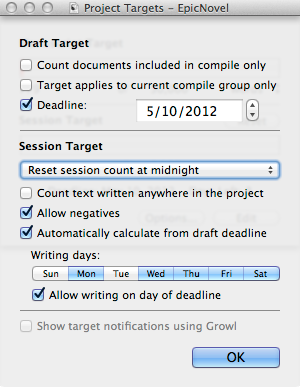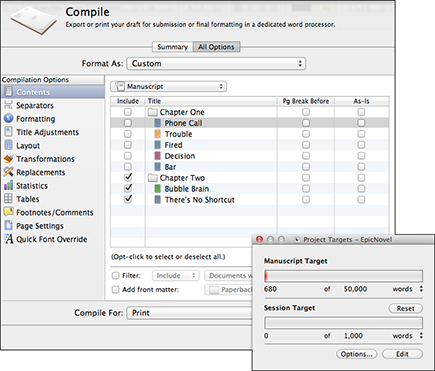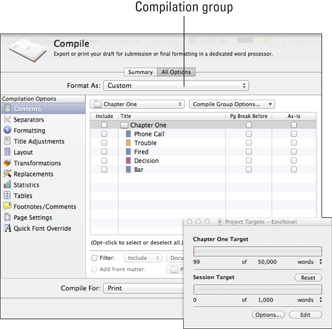Figure 14-1: Setting a session target.
Working with Project Targets
Writing into the fog is fine, but sometimes you need to shoot for a specific goal. Scrivener’s project targets provide visual feedback on how you’re doing, and you can set them up to calculate the number of words you need to write daily to meet a deadline.
Whether you have a 400-page novel due in six weeks, want to write 50,000 words for National Novel Writing Month (NaNoWriMo) this year, or are just trying to practice your discipline by writing 500 words each day, project targets can help.
Setting a draft and session target
A draft target is the total word count goal for the project. A session target is specific to your current writing session, and you can use it in addition to a draft target. Even though you might be working toward an ultimate goal of 50,000 words for your manuscript, if your target for the day is 1,000 words, then 1,000 is your session target.
Note: In the Novel template that I used for the examples in this book, the Draft folder is called Manuscript, so the draft target is called the manuscript target. To be consistent with the figures, I call it the manuscript target from here forward.
Only items in the Manuscript (Draft) folder count toward your manuscript target, and by default, Scrivener calculates the words written toward your target from documents for which you have selected Include in Compile (see the section “Adjusting the target options,” later in this chapter).
Imported documents or documents moved into the Manuscript folder from elsewhere in the Binder don’t increase the session count, just like documents removed from the Manuscript folder don’t detract from it. (Documents added or removed affect the manuscript target progress, though.)
You can easily set a manuscript or session target by following these steps:
1. Choose Project⇒Show Project Targets.
You choose Project⇒Project Targets on a Windows PC.
The Project Targets window opens. It’s broken into two sections, with Manuscript Target settings in the top half. (I show working with these settings in Figure 14-1.) The Session Target section appears in the bottom half. The bars in both sections are progress meters that fill with color in graduating shades from red to green while you get closer to meeting the goals.
The number on the left shows how many words are in the manuscript, and the number in the text box to the right is the goal amount.
2. (Optional) Change the progress bar colors by choosing Scrivener⇒Preferences, clicking the Appearance button at the top of the window that opens, and choosing Target Progress Bars in the Customizable Colors section.
3. Click the goal number to activate the text box.
If you set up the session target to calculate automatically from a deadline (see the “Adjusting target options” section, later in this chapter), you can’t edit this number for the session target.
4. Type the desired number.
5. Mac users, click Apply.
The option is a standard text box in Windows, so you don’t have an Apply button to click.
If you have any text already entered in the manuscript, the progress bar fills — and is colored — according to how much of the goal you’ve met.
If you need to cut words, you can set a negative session target. The count appears correctly if you change the settings to allow negatives (see the section “Adjusting the target options,” later in this chapter), but the progress bar doesn’t show progress.
6. From the Words drop-down list, select whether you’re measuring Words, Chars (characters), or Pages.
The Pages option is available only for the manuscript target.
7. Click the X in the upper-left corner of the window to exit.
Alternatively, Mac users can press Esc.
To view your progress, open the Project Targets window. You can adjust the manuscript or session target at any time by repeating the preceding steps. If you want, you can even leave the window open while you work so that you can keep track of your progress in real time.

Resetting the session count
Did you read through yesterday’s work and delete a few lines, but you don’t want that to count against today’s writing?
Whatever the reason, you can easily reset the session count. Just open the Project Targets window by choosing Project⇒Show Project Targets, and then click the Reset button (refer to Figure 14-1).
The session progress resets to zero.
Adjusting the target options
The Targets Options window allows you to modify the way Scrivener calculates progress for manuscript and session targets, change when it resets session counts, set deadlines, and more.
To open the Project Targets Options window, choose Project⇒Show Project Targets, and then click the Options button. (Windows users, choose Project⇒Project Targets.)
The Project Targets Options window appears, as shown in Figure 14-2. The first three options apply to manuscript targets, the rest apply only to session targets.
Figure 14-2: The Project Targets Options window.

Count Documents Included in Compile Only
If this option is selected, only words added to documents that are marked to Include in Compile — either in the Compile window (see Chapter 12) or in the General Meta-Data section of the Inspector pane (see Chapter 4) — count toward target progress.
So, if you recently compiled the first three chapters of your manuscript, the progress toward your goal might suddenly look much smaller because only those documents are being used to count words added.
Figure 14-3 shows the Compile window with only Chapter Two files selected for inclusion. The progress bar in the Project Targets window shows the 680 words contained in Chapter Two, but this manuscript actually has 779 total.
Figure 14-3: The Manuscript Target progress bar reflects only those items selected to include in Compile.

Target Applies to Current Compile Group Only
If this option is selected, only those files currently listed in the Compile window’s Contents pane count toward your goal (see Chapter 12), regardless of their Include in Compile status.
Figure 14-4 shows how this option works. Even though none of the documents are marked for inclusion, those in Chapter One — all 99 words — are still counted in the Project Targets window because they’re listed in the Compile group. Words in Chapter Two aren’t counted because they’re not part of the group.
If you used this option in conjunction with Count Documents Included in Compile Only, the progress count in Figure 14-4 would be zero because none of the files have Include in Compile selected.
This option is best left blank if you don’t want the compile settings messing with your progress counts.
Figure 14-4: The Manuscript Target progress bar reflects those items in the Compile group, even if they’re not selected for inclusion.

Deadline
Select this option to enter a deadline that can be used to automatically calculate your daily writing goals (see the section “Setting a draft and session target,” earlier in this chapter).
Reset Session Count
This drop-down list lets you choose when Scrivener resets the session count to zero. If you don’t want Scrivener to reset the session count automatically, even on project open or close, choose Never Automatically Reset Session Counts.
By default, Scrivener resets the session count at midnight.
Count Text Written Anywhere in the Project
Choosing this option forces Scrivener to count all text written, regardless of location, even in documents outside the Manuscript (Draft) folder.
You might use this option if you want to work on a scene but aren’t yet ready to include it in the manuscript, or when you want to count the words written in your notes or research.
Words written outside the Manuscript (Draft) folder don’t count toward the manuscript target progress, even if this option is selected.
Allow Negatives
Selecting this option allows the session count to go below zero. If you leave it unchecked, the count doesn’t go negative, even if you delete more words than you add.
If this option is deselected, Scrivener doesn’t keep track of how negative you are, so any words added when you’re at zero increase your session target progress. If you want a more accurate reflection of your net word count, select this option.
Automatically Calculate from Draft Deadline
This option uses the deadline date (see the “Deadline” section, earlier in this chapter) to determine the daily target needed to meet the deadline.
If this option is selected, the session target can’t be edited.
Writing Days
Select the buttons for the days of the week you plan to write so that Scrivener can more accurately calculate the daily session goal. Otherwise, it assumes seven days per week. Chosen days turn blue.
Allow Writing on Day of Deadline
Select this option if you can work on the deadline day. If this option isn’t selected, Scrivener doesn’t include the deadline date when making calculations.
Show Target Notifications
This Mac-only option applies to both target types. If you have Growl installed on your computer (go to http://growl.info
to find out more), selecting this option triggers a Growl notification when you reach either your session or manuscript target, or fall below a target (useful when cutting words). This option eliminates the need to open the Project Targets window to see whether you’ve reached your goal.
Don’t want to use Growl? Target notifications also work with Apple’s notification system for Mac OS X Mountain Lion.


 Front matter that you add to the compile group isn’t counted, but items removed via filter are.
Front matter that you add to the compile group isn’t counted, but items removed via filter are.